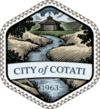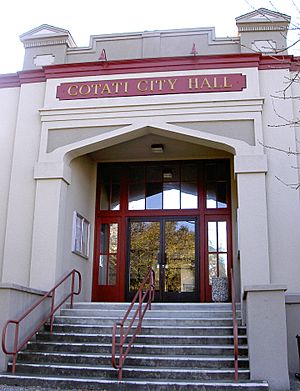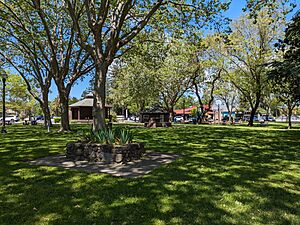Cotati, California facts for kids
Quick facts for kids
City of Cotati
|
|||
|---|---|---|---|
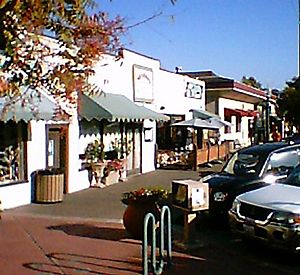
Downtown Cotati
|
|||
|
|||
| Nickname(s):
The Hub of Sonoma County
|
|||

Location of Cotati in Sonoma County, California
|
|||
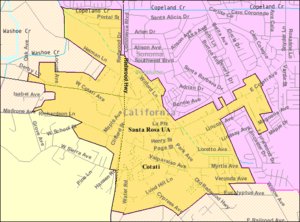
City boundaries as of 2000
|
|||
| Country | United States | ||
| State | California | ||
| County | Sonoma | ||
| Incorporated | July 16, 1963 | ||
| Named for | Rancho Cotate | ||
| Government | |||
| • Type | Council–manager | ||
| Area | |||
| • Total | 1.88 sq mi (4.86 km2) | ||
| • Land | 1.87 sq mi (4.85 km2) | ||
| • Water | 0.00 sq mi (0.01 km2) 0.17% | ||
| Elevation | 112 ft (34 m) | ||
| Population
(2020)
|
|||
| • Total | 7,584 | ||
| • Density | 4,046.96/sq mi (1,562.23/km2) | ||
| California Department of Finance estimate | |||
| Demonym(s) | Cotatian | ||
| Time zone | UTC−8 (Pacific Time Zone) | ||
| • Summer (DST) | UTC−7 (PDT) | ||
| ZIP codes |
94926–94928, 94931
|
||
| Area code | 707 | ||
| FIPS code | 06-16560 | ||
| GNIS feature IDs | 1655927, 2410240 | ||
Cotati is a small city in Sonoma County, California, in the United States. It is about 45 miles (72 km) north of San Francisco. Cotati is located along Highway 101, between Rohnert Park and Petaluma.
In 2020, about 7,584 people lived in Cotati. This makes it the smallest city in Sonoma County. Cotati is part of the San Francisco Bay Area and the North Coast region. It is also considered part of Wine Country.
One special thing about Cotati is its downtown plaza. It has a unique six-sided (hexagonal) shape. This is very rare in the United States. Only one other city, Detroit, Michigan, has a similar hexagonal layout. Cotati's plaza is so special that it is a California Historical Landmark.
Contents
History of Cotati
Early Days and Native Americans
Native American people called the Coast Miwok lived in the Cotati area for a very long time. They built villages near streams, starting around 2000 BC. Some of their villages were called Lumen-takala, Payinecha, and Kotati. The name "Cotati" comes from the Coast Miwok village of Kotati.
In 1827, an Irishman named John Thomas Reed tried to build a cabin here. But the native people burned it, and he moved away.
Rancho Cotate Land Grant
In 1844, the Mexican government gave a large piece of land called Rancho Cotate to Captain Juan Castaneda. This land included what is now Cotati, Penngrove, and Rohnert Park. Captain Castaneda was a soldier from Texas. He never developed the land, so he lost it.
Later, the land was sold to Dr. Thomas Stokes Page in 1849. The Rancho Cotate was a huge area, about 17,238 acres (6,976 hectares). The Page family owned this land for over 80 years. They used it for grazing cattle and sheep.
In 1870, a railroad was built from Petaluma to Santa Rosa. A small town grew up around a train stop on Dr. Page's land. It was first called Page's Station, and then Cotati.
Developing the Town
The unique hexagonal shape of Cotati's downtown plaza and its street layout were designed in the 1890s by Newton Smyth. Dr. Thomas Page's barn used to be where the plaza is now. The streets around the plaza are named after his sons. In 1892, the Page family started selling off parts of their ranch.
In 1906, a big earthquake in San Francisco also shook the Cotati area. Many chimneys fell down.
The Northwestern Pacific Railroad built the Cotati Depot in 1907. It was later taken down to make way for the new Sonoma–Marin Area Rail Transit (SMART) train station.
Before 1915, the main roads bypassed Cotati. But that year, U.S. Route 101 was routed through Cotati Boulevard. The highway even passed through the downtown plaza until 1955, when it was moved further west.
The old schoolhouse in Cotati burned down in 1921. A new school was built in 1922 on the same spot. This building has been the Cotati City Hall since 1971.
Around 1921, a wooden track for car racing called the Cotati Speedway was built. World records were set there, but it closed down in 1922. The Cotati Volunteer Fire Department started in 1927.
Becoming a City and Growing
On July 2, 1963, the people of Cotati voted to make their town an official city. After this, Cotati grew quickly. Many people moved there because it was easy to travel to San Francisco for work. Between 1965 and 2000, the population grew more than four times!
In 1979, Cotati voters approved a rule about how much landlords could charge for rent. This rule was later changed by state laws. In 1990, Cotati citizens voted to limit how much the city could expand. In 1997, they voted to stop very large stores from being built. However, in 2003, voters allowed an exception for a Lowe's home improvement store.
In recent years, Cotati has faced money challenges. To help, the city has made budget cuts and increased its sales tax.
Geography and Climate
Cotati covers about 1.89 square miles (4.89 square kilometers). Most of this area is land, with a very small amount of water.
The city is about 17 miles (27 km) from the Pacific Ocean. It is in an area where water flows into the Laguna de Santa Rosa.
Because of a "gap" in the coastal hills near Petaluma, ocean fog often reaches Cotati in the summer. This makes Cotati cooler and less sunny than nearby cities like Santa Rosa and Sebastopol.
The ground in Cotati is mostly made of materials brought by streams and valleys. There are also active faults nearby, like the Rodgers Creek Fault. West of Cotati, there are wetlands that are home to several endangered species of plants.
People of Cotati (Demographics)
| Historical population | |||
|---|---|---|---|
| Census | Pop. | %± | |
| 1960 | 1,852 | — | |
| 1970 | 1,368 | −26.1% | |
| 1980 | 3,346 | 144.6% | |
| 1990 | 5,714 | 70.8% | |
| 2000 | 6,471 | 13.2% | |
| 2010 | 7,265 | 12.3% | |
| 2020 | 7,584 | 4.4% | |
| U.S. Decennial Census | |||
In 2020, Cotati had a population of 7,592 people. Most residents were White (79.6%), and 18.6% were Hispanic. About 21.3% of the people were under 18 years old. The average age in Cotati was 37.2 years.
In 2010, the population was 7,265. About 81.6% were White, and 17.3% were Hispanic. About 21.9% of the population was under 18. The average age was 36.2 years.
In 2000, there were 6,471 people. About 89% of residents spoke English as their main language. About 11% spoke other languages, with Spanish being the most common.
Economy
The Cotati Chamber of Commerce is a group that helps businesses in the city. They work to make Cotati's economy strong. They also help organize community events.
Fun Things to Do (Arts and Culture)
Cotati has many fun events throughout the year:
- Pasta Feed and Bingo Night: A fundraising event, usually in late February or early March.
- Farmers' Market: Held every week from June to September.
- Cotati Accordion Festival: A famous festival held since 1991, usually in mid-August.
- Cotati Earth Day: Celebrated around the end of June.
- Kids Day Parade and Festival: Usually in mid-July.
- Oktoberfest: Held every October.
- Holiday Tree Lighting Ceremony: Usually in early December.
- The Downtown Cotati Shop and Stroll: A street fair with local crafts, food, music, and activities, held the Saturday after the tree lighting.
Parks and Recreation
Cotati has several parks for people to enjoy:
- Cator Field: Has basketball courts.
- Helen Putnam Park: Has a dog park and a soccer field.
- Kotate Park: A playground.
- La Plaza Park: Located in the center of town, it has a bandstand and hosts many annual events.
Education
Cotati is part of the Cotati-Rohnert Park Unified School District. The only public school actually in Cotati is Thomas Page Elementary School. Most high school students go to Rancho Cotate High School in nearby Rohnert Park.
Sonoma State University, a public college, is about 1 mile (1.6 km) east of Cotati. It brings many students and activities to the area.
The Sonoma County Library serves Cotati. It has branches in Rohnert Park and Petaluma.
Transportation
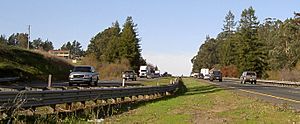
Cotati has bus routes run by Golden Gate Transit and Sonoma County Transit.
For air travel, the closest major airports are San Francisco International Airport and Oakland International Airport. The Santa Rosa airport is closer and also offers passenger flights.
U.S. Route 101 passes through Cotati. The part of the highway near Cotati is called the Cotati Grade.
The Sonoma–Marin Area Rail Transit (SMART) train started service to its Cotati station in August 2017.
See also
 In Spanish: Cotati para niños
In Spanish: Cotati para niños


